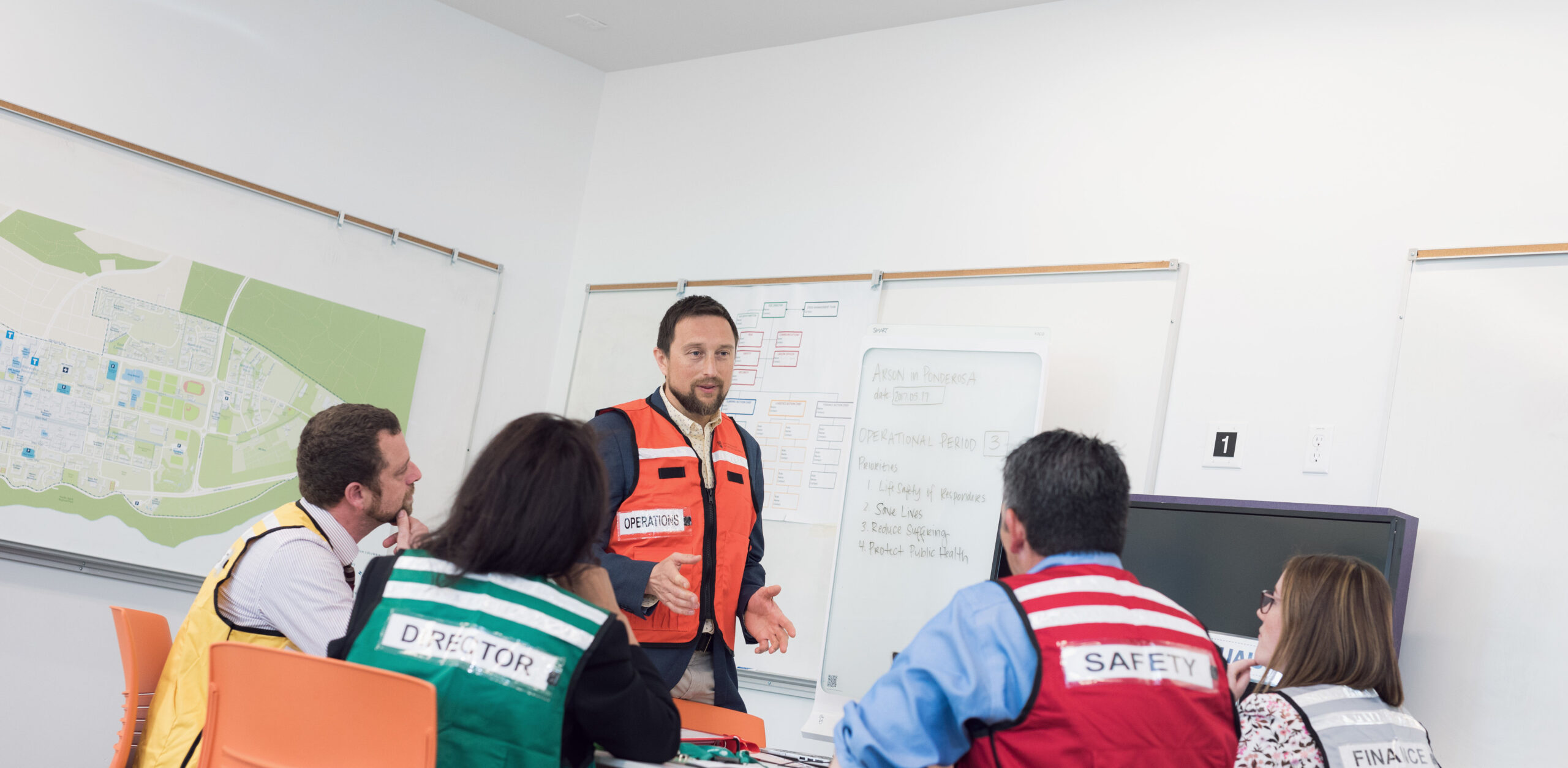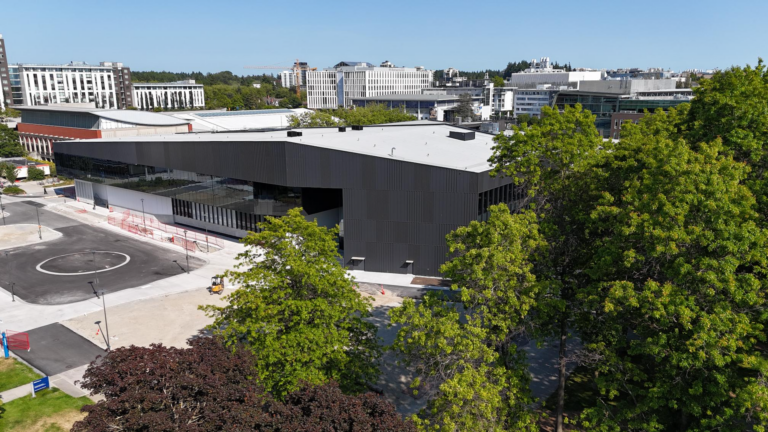Planning for disaster a campus-wide initiative for UBC Vancouver
If disaster strikes, UBC Vancouver is prepared to support its community.

If disaster strikes, UBC Vancouver is prepared to support its community.
If disaster strikes, UBC Vancouver is prepared to support its community.
Perched on an isolated cliff-top peninsula, surrounded by ocean, and separated from Vancouver’s urban core by a sprawling, lush rainforest, UBC falls outside the City of Vancouver’s jurisdiction. As a result, the university is responsible for the types of services most universities typically don’t manage—including staffing and sourcing their own emergency response operations (with the exception of police, fire and ambulance).
“There’s a range of unique considerations UBC has to account for when planning how we respond to emergencies on campus,” says Danny Smutylo, director of emergency management at UBC Vancouver. “For example, we aren’t a municipality but we manage a majority of our own municipal infrastructure, such as waste management, energy generation and distribution, community planning, building inspection services, and water services. There’s a lot of opportunity to create our own processes and procedures based on the systems we control. That’s an advantage most post-secondary emergency planners can’t rely on.”
Smutylo’s team, part of UBC Vancouver’s Safety & Risk Services department, directs a diverse and comprehensive emergency management program designed to protect and care for students, the wider UBC community, and neighbouring partners, including local First Nations, the University Endowment Lands, and the University Neighbourhood Association. The university, which has adopted the British Columbia Emergency Management System (BCEMS), promotes a coordinated, organized response and recovery to any type of emergency incident.
“We spend the vast majority of our time looking at ways to reduce the impact of a disaster on our community, and testing and retesting our strategies,” says Smutylo. “The goal is to enhance the university’s resilience by improving capabilities and resources to respond when an incident occurs. This means working with a wide variety of emergency responders and planners, inside and outside the university community. As partners we consult on best practice and train together. We also activate the same response structures in all of our drills and exercises, and in real life situations.”
[big_feature_image src=”http://news.ubc.ca/wp-content/uploads/2019/10/Emergency_preparedness.jpg”][/big_feature_image]
This includes Incident Management Teams (IMT), which perform operational elements of the response—tending to the wounded, distributing food and blankets, coordinating resource deployment to pre-identified, centralized locations on campus, and more. An Emergency Operation Centre manages strategic planning to ensure the IMTs have all the resources they require, while the Crisis Management Team (CMT) looks at policy, funding, and government decisions. Comprised of representatives from the university’s executive, the CMT also communicates and coordinates with the UBC Board of Governors and the provincial government.
The type of event will demine the level of activation required on campus—and how much support can come in from the outside.
“If it’s an isolated or local incident, for example, UBC can access resources from outside—RCMP, fire services, ambulance,” says Smutylo. “If it’s a regional event, however, like an earthquake, UBC will operate independently until regional or provincial resources can be safely deployed. That’s why we’re zeroed in on mass care and infrastructure. If students can’t return to their residence rooms or members of the community need food, where do they go? Our goal is to guarantee they have clean water to drink, food to eat, beds to sleep on, and basic health and social supports.”
This has led to many innovations in how the university plans for emergencies.
“While we need to have the resources and systems in place for emergency deployment, we also need to have the resources and systems in place to maintain our equipment so we are prepared for however long a disaster lasts,” says Smutylo.
One pathway to creating integrated processes and procedures has been the creation of Emergency Support Functions (ESF)—pan-university planning initiatives and working groups. The groups bring together representatives from complimentary departments to work towards common goals when an incident happens.
Two of these key working groups are ESF Mass Care and ESF Infrastructure and Utilities. ESF Mass Care is responsible for food, shelter and care, and includes experts from Student Housing & Hospitality Services, Building Operations, Security, Safety & Risk Services, and Student Health Services. Its purpose is to identify and implement required emergency infrastructure, population mapping and meal planning, and to support resource procurement, which could include food, cots and blankets.
ESF Infrastructure and Utilities primarily includes experts from UBC’s Building Operations and Energy & Water Services departments. Its purpose is to identify and implement the necessary strategies and resources to ensure campus buildings are safe, have power, potable water, sanitary infrastructure and the like. This includes the development of water filtration units, water transport vehicles, generators, fuel and food storage options, emergency kits, damage assessment teams and much more.
“The people in the working groups will also be on-site when an emergency happens, tasked with executing the plans they are creating in these groups,” says Smutylo. “We are very focused on optimizing as much as possible—having the right people in the right places, and providing them with the resources they need to make sure our infrastructure is safe and systems and people are resilient.”
When an incident happens, mass notifications are sent out in blanket messages across campus. A new app is also in development to activate specialized teams—like the Mass Care Team or Damage Assessment Team. The app will also facilitate mobilization to pre-established staging sites and equipment depots, as well as provide incident supports and updates.
“Emergency response has historically been reactionary—a wildfire or hurricane happens, and responders kick into gear,” says Smutylo. “Responding is obviously crucial, but mitigating damage through prevention and planning is also key. It’s the foundation everything is built on. With climate change altering the frequency, severity and size of natural disasters, we need to be smarter and more agile in our capacity. The more knowledge we have, the better prepared we are to meet any eventuality—it’s the goal of our program, and we take it very seriously.”
Emergency Management is part of UBC’s Safety & Risk Services department and the VP Finance & Operations Portfolio. To learn more about disaster response at UBC, visit the university’s Emergency Preparedness website.
ShakeOutBC Day takes place across the province, and at UBC, Oct. 17.



